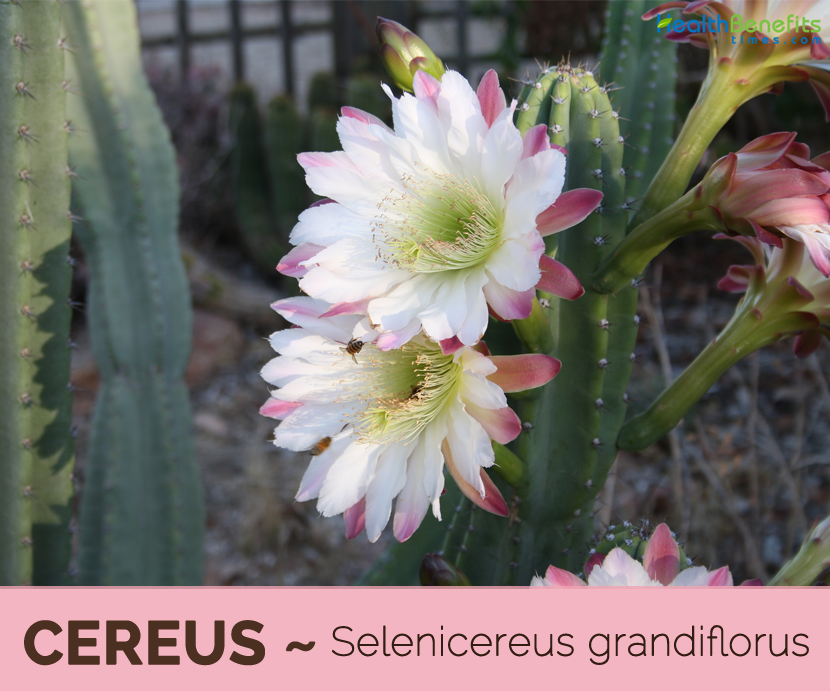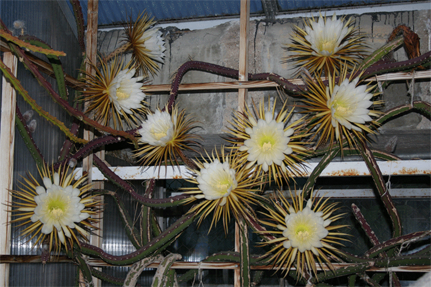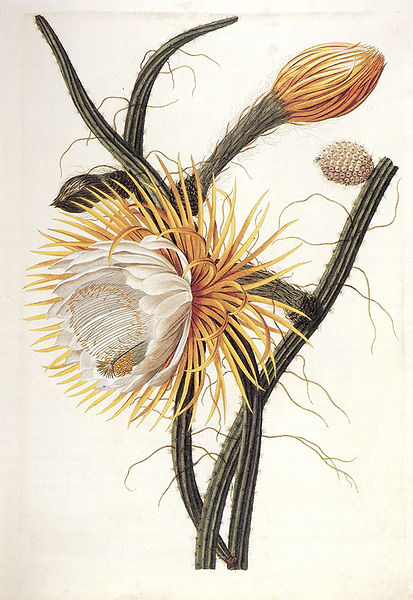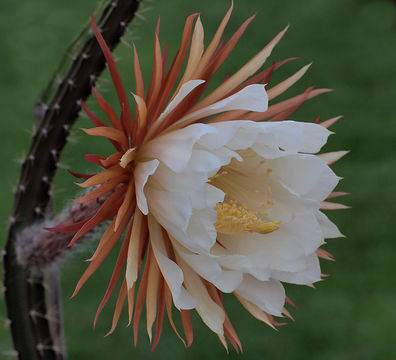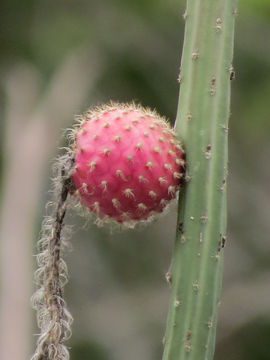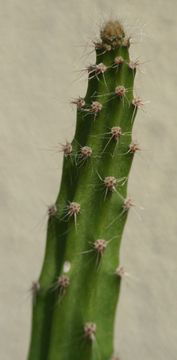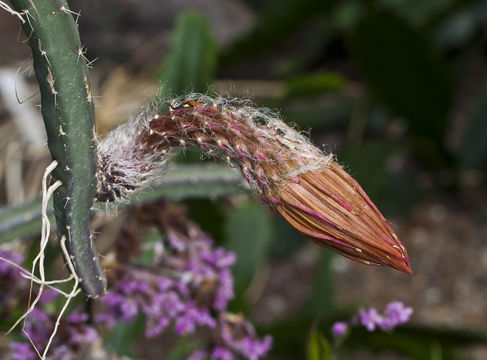| Cereus Quick Facts |
| Name: |
Cereus |
| Scientific Name: |
Selenicereus grandiflorus |
| Origin |
Desert and semi-desert regions of the Antilles, tropical America, Mexico, and the southern United States |
| Colors |
Red-orange |
| Shapes |
Ovate, covered with scaly tubercles, fleshy, short-spined elliptical fruit about three inches long |
| Taste |
Bitter |
Night Blooming Cereus (Selenicereus grandiflorus) is an exquisite flowering plant which is considered to be nocturnal since it opens in the evening and closes at dawn. It is a plant species of the family Cactaceae and it is commonly known as princess of the night, Honolulu queen, Christ in the Manger, Dama de Noche, queen of the night, sweet-scented cactus, large-flowered cactus, vanilla cactus, large blooming cereus, large-flowered torch thistle, lunar flower and organillo. The plant is native to the desert and semi-desert regions of the Antilles, tropical America, Mexico, and the southern United State. It is described as a creeping shrub with cylindrical stems with prickly spines. Its flowers are very large and emit a vanilla like perfume in the evening hours. The flowers of the Night Blooming Cereus Stem last only for 6 hours and do not bloom again when withered. The name Night Blooming Cereus or Selenicereus is derived from the Greek word selene and Cereus which means moon.
Plant Descriptions
Cereus is a fleshy, creeping, rooting shrub found growing in a well-drained soil rich in organic matter. It has tuberous, turnip-like root usually weighing 5 to 15 pounds. Stem is green to bluish green, becoming purplish along ribs, to several m, 1-2.5 cm diam.; ribs 5-8, low; areoles usually 1-2 cm apart along ribs, 1-2 mm diam. The plant consists of spines that are deciduous, 6-18 per areole, whitish to brownish, ± bristle like or short acicular, 4.5-12(-15) mm, intermixed with long, whitish hairs; radial and central spines not distinguishable.
Flower & Fruit
The plant consists of fragrant trumpet-shaped flowers that are up to 4 inches wide and as much as 8 inches long. The outer petals of the flower are brown, orange or lemon yellow; the inner petals are white, oblanceolate, with an acute apex. The areoles of the ovary and flower tube bear long hair like spines. The waxy, creamy-white, many-petaled flowers are followed by an ovate, covered with scaly tubercles, fleshy, short-spined elliptical fruit about three inches long. The fruit consists of many small seeds that are acidic in nature. Night blooming Cereus will not begin to flower until it is four or five years old and will begin with just a couple of flowers. The Night Blooming Cereus Stem should be collected in July when the plant is fresh. A tincture from the Night Blooming Cereus Stem is considered to be a homeopathic treatment for many health problems.
Traditional uses and benefits of Cereus
- Indigenous peoples of America have used the night blooming cereus as a topical remedy for rheumatism and itchy rashes, as well as an internal herbal remedy for worms, cystitis and fever.
- Native American tribe Death Valley Shoshone called this plant “pain in the heart”, and used it to treat angina-like pains.
- Several other tribes of Native Americans use the stem to treat diabetes.
- Night blooming cereus has a history of use in traditional herbal medicine as a treatment for hemoptysis and edema.
- It is use as an herbal treatment for heart conditions and it is highly valued by traditional herbalists as a natural treatment for heart palpitations, angina, weak or irregular pulse, and for relieving shortness of breath.
- It is believed to be a useful natural treatment to help normalize heart rhythm and strengthens contractile force.
- It is also used by traditional herbalists as a natural treatment to tone the heart muscle, reduce blood fat and cholesterol, and increase circulation.
- It is considered to be helpful as a diuretic, a stimulating cardiac tonic, a cardiac tropho-restorative, and as a stimulant and tonic for the spinal and motor nerves.
- It has been used as a homeopathic treatment for digestive ailments with flatulence and cramp-like pains, as well as an herbal remedy for pain associated with menstrual cramps.
- It is a traditional herbal treatment for nervous disorders of all types, sea and motion sickness, low body temperature, cold sweats, and edema.
- A liquid extract of the Night Blooming Cereus Stem may also relieve shortness of breath and tobacco poisoning.
Culinary Uses
- The dried flowers of the night-blooming cereus are a common ingredient used in Cantonese slow-simmered soup.
Other Facts
- In the 15th century, Christopher Columbus brought this curative plant to Europe.
- Flower only lasts in bloom about six hours and does not revive- when withered.
- The plant contains a milky acrid juice.
Precautions
- An overdose of this herb may cause gastric irritation, a rapid and erratic heartbeat, cardio spasm or a feeling of constriction in the chest.
- It may cause slight delirium, hallucinations, and general mental confusion.
- If you are lactating or pregnant, Night Blooming Cereus Stem must not be used for any reason since it may cause fetal abnormalities and decreased blood pressure.
- If you are using any cardiac medications, ask your doctor for advice regarding Night Blooming Cereus Stem use.
- Night-Blooming Cereus lowers cholesterol and also works to sooth away inflammation of the bladder.
- Contact of juice with the mouth may result in a feeling of burning possibly associated with nausea, vomitus and diarrhea.
- Dermal contact of the fresh juice of Selenicereus grandiflorus may cause skin irritations with pruritus and pustules.
References:
https://plants.usda.gov/core/profile?symbol=SEGR10
https://www.itis.gov/servlet/SingleRpt/SingleRpt?search_topic=TSN&search_value=505117#null
https://npgsweb.ars-grin.gov/gringlobal/taxonomydetail.aspx?id=33593
https://en.wikipedia.org/wiki/Night-blooming_cereus
http://www.botanical.com/botanical/mgmh/c/cernig48.html
https://en.wikipedia.org/wiki/Selenicereus_grandiflorus
Comments
comments


